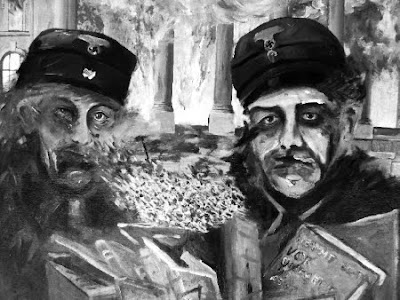Recently while on a trip to Berlin, I was rereading in a night train one of Haim Hazaz's short stories, "The Sermon", which had been a subject for our discussion in a Jewish History seminar. I glanced through the pages and ruminated at some length. Repeating the platitude can be a bore. Then, all of a sudden, this line caught my eye: "The talk is over! Boys, go out and play football."
As I set off to Berlin, the ongoing event of World Cup rendered me a feel of fresh excitement. Surely Berlin was a place brimming with historical poignancy and I had expected my first-time visit to the city to be an experience delved mostly into the past. It's hard to imagine, indeed, history could be in any way eschewed in Berlin. But still, I began to sense the inexorable pull of time right here and wondered aloud how man should properly advance in a different playfield than erstwhile was the case.
Many thoughts linger on my mind. For now I share with you some snapshots of Jewish Berlin that I hope you find interesting.
1. The New Synagogue in Oranienburger Street. The main hall is no longer there nowadays. Really impressive façade at the street front. On the Kristallnacht the synagogue remained undamaged because "a courageous German police officer preserved it being burnt down".

2. Jewish Museum Berlin by Daniel Libeskind. Had a tour of the current show on Freud. What a great museum! I wished I could have more time to explore the collections inside. Libeskind's architectural statement was way too strong for me, though. I wasn't so sure I agreed with him.

3. Denkmal für die ermordeten Juden Europas or Memorial to the Murdered Jews of Europe. Close to Brandenburg Gate. Many football fans from the globe stopped by and appeared curious.

4. A wall painting in the middle of the city. The turbulent 1930s.

5. Jewish community house not far away from Kaiser Wilhelm Church. I didn't get in.

6. Moses Mendelsohn's tomb. I really liked the tranquil atmosphere in the area although the historical reality couldn't be more different.

7. The statues stand in the same yard as 6. I didn't manage to figure out who was the sculptor but you could easily guess what was the theme. Nearby there are two apartment houses whose walls bear several memorial plates. These two houses were parts of one same building in the past. The separation in between as we see today was due to the Allies' air raids during the war era.

8. The location for Führerbunkern (Hitler's Bunker) was just marked publicly by the city government.

Inga kommentarer:
Skicka en kommentar